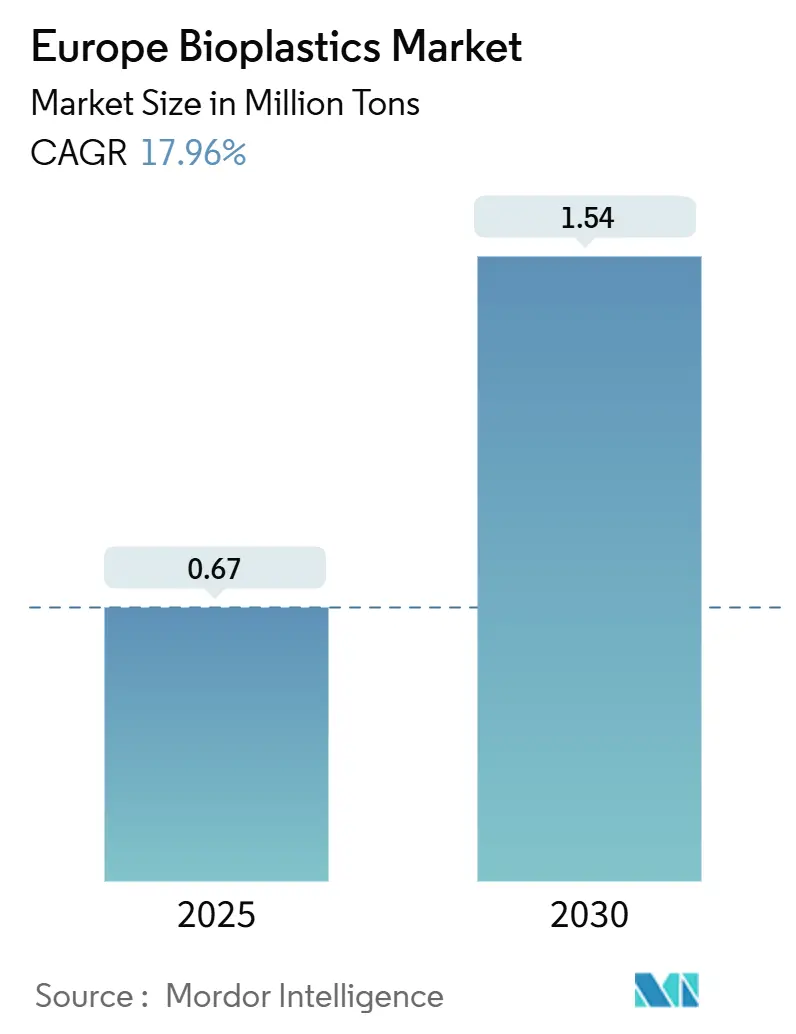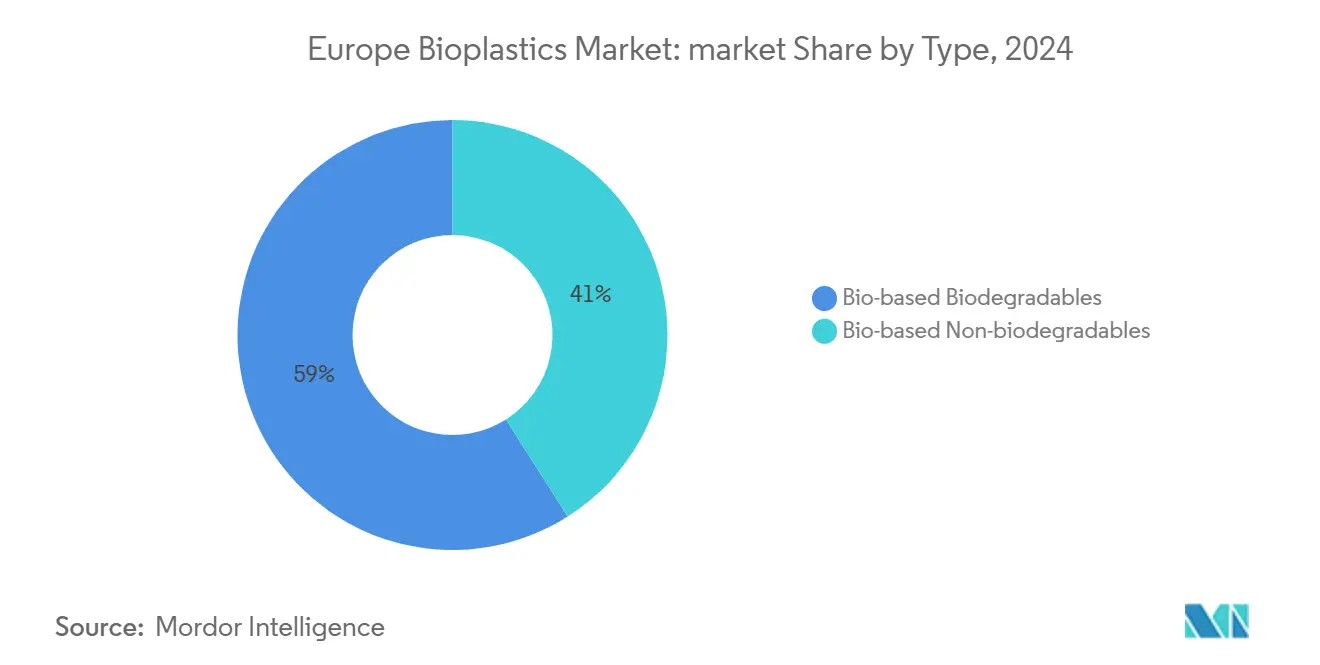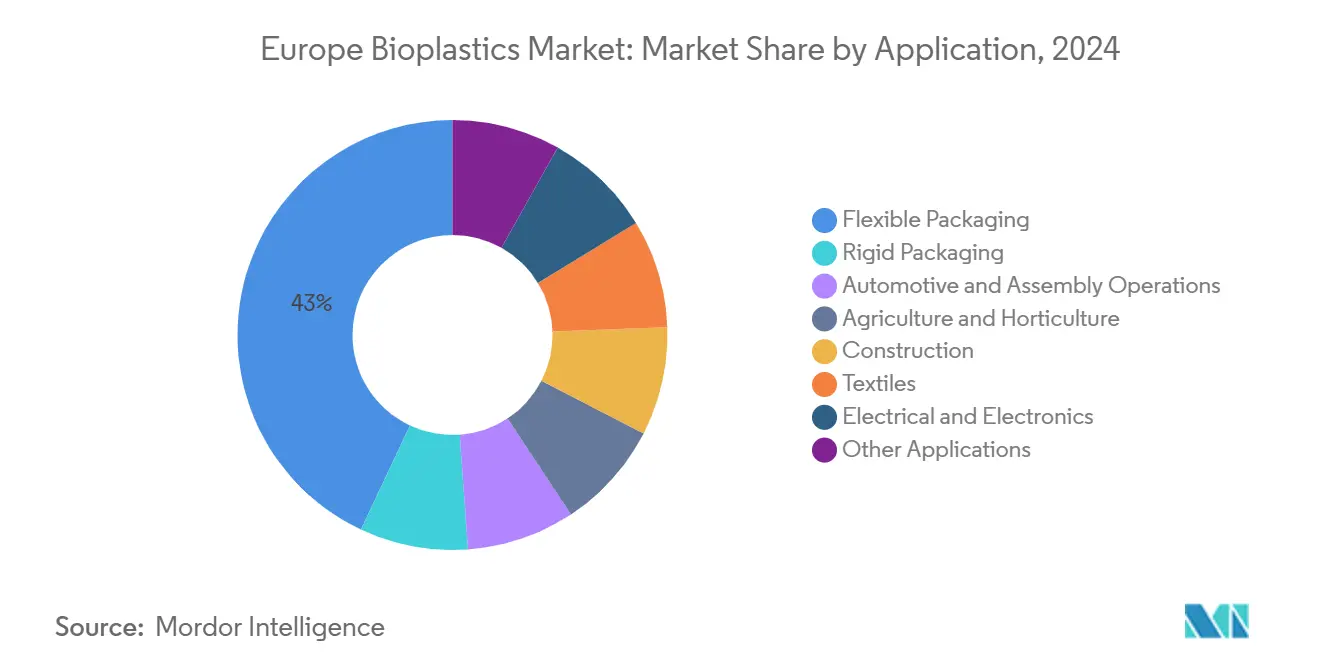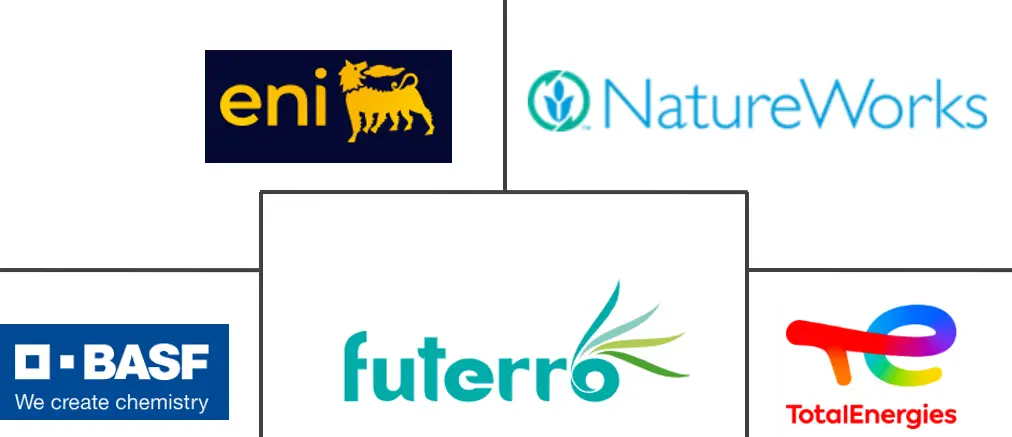
Europe Bioplastics Market Analysis by Mordor Intelligence
The European bioplastics market is currently 0.67 million tons in 2025 and is on track to reach 1.54 million tons by 2030, supported by a forecast compound annual growth rate (CAGR) of 17.96% between 2025 and 2030. Policymakers across the EU are tightening rules on fossil-based polymers, so manufacturers are treating bio-based alternatives as an essential rather than optional upgrade, a shift that is filtering through procurement departments in food, retail, automotive, and consumer-goods value chains.
Key Report Takeaways
- By type, Bio-based Biodegradables accounted for the largest share, holding 59% of the total revenue in 2024, and are also expanding at a CAGR of 22.56% through 2030.
- By feedstock, sugarcane accounted for 44% of the total revenue, while cellulosic and wood waste are the fastest-growing segments with a CAGR of 22.3%.
- By processing technology, extrusion held the largest share in 2024 with 47% of the total market, while 3D printing is expanding at a CAGR of 21.5%.
- By application, flexible packaging with a 43% share of the market in 2024, is also the fastest-growing segment with a CAGR of 22.89%.
- By country, Germany held the largest share in 2024 with 25% of the total market, while the United Kingdom is growing at a CAGR of 19.71%.
Europe Bioplastics Market Trends and Insights
Driver Impact Analysis
| Drivers | (~) % Impact on Market CAGR | Geographic Relevance | Impact Timeline |
|---|---|---|---|
| EU Single-Use Plastics Directive | +5.2% | EU-wide, strongest in Western Europe | Medium term (≈3-4 yrs) |
| Growing Demand for Bioplastics in Packaging | +4.8% | EU-wide, led by Germany, France, Italy | Short term (≤2 yrs) |
| Environmental Factors | +3.1% | EU-wide, strongest in Nordic countries | Long term (≥5 yrs) |
| Government Procurement Policies | +2.5% | EU-wide, led by Germany and France | Medium term (≈3-4 yrs) |
| Ban on Fossil-Based Plastics | +4.3% | EU-wide, strongest in Western Europe | Medium term (≈3-4 yrs) |
| Source: Mordor Intelligence | |||
EU Single-Use Plastics Directive Triggering Mandatory Compostable Solutions by 2030
The Directive’s phased bans and recycled-content quotas are creating structural pull for compostable biopolymers in items such as coffee caps, produce bags, and quick-service trays. Since the law uses material performance criteria rather than brand names, producers can position PLA, PHA, or starch blends as compliant pathways that also score carbon-intensity gains. Member-state timelines differ, so companies with modular production recipes are capturing early share in markets that front-load enforcement. An immediate observation is that differing fee structures, especially in Poland and Ireland, encourage local sourcing of renewable feedstocks to cut transport footprints, subtly tilting supply chains toward regionalised hubs.
Growing Demand for Bioplastics in Packaging
Flexible packaging already holds 43% European bioplastics market share and is growing at nearly 23% CAGR, because film and pouch makers can often substitute a single layer without overhauling entire filling lines. Brand owners report that switching from fossil PE to bio-PE or to a compostable laminate yields marketing benefits that offset modest price premiums, so sales teams pitch these materials as revenue protectors rather than pure cost items. Innovation hubs such as Mondi’s FlexStudios demonstrate how co-development with customers cuts lead times and unlocks line-speed parity with incumbent resins. The implicit takeaway is that converters who master both extrusion and barrier-coating know-how gain bargaining power in negotiations with multinational food companies.
Government Procurement Policies Favoring Bio-content in Public-Sector Packaging
The EU Clean Industrial Deal unlocks more than EUR 100 billion (~USD 116.77 billion) for low-carbon materials, earmarking bioplastics as eligible under its Industrial Decarbonisation Accelerator Act[1]European Commission, "Clean Industrial Deal," commission.europa.eu. Municipalities purchasing school-meal trays or medical disposables can claim compliance credits when they specify minimum bio-content, so long as the underlying polymers meet performance norms. Germany’s Bioeconomy Dialogue Platform multiplies this effect by pooling demand forecasts across ministries, allowing producers to size new units with clearer visibility on offtake. The practical inference is that public tenders have become demand anchors, giving banks the confidence to finance capacity expansions that would have looked speculative five years ago.
Ban on Fossil-Based Plastics in Specific Applications
The Packaging and Packaging Waste Regulation that takes effect in 2025 prohibits PFAS additives and forces recyclability by 2028, creating natural niches where compostable or bio-attributed resins carry lower compliance risk[2]O'Keeffe, Hazel, "The New EU Packaging and Packaging Waste Regulation – Highlights and Challenges Ahead," www.packaginglaw.com . Food-contact items that are often contaminated, such as tea bags, snack wrappers, and cutlery, fit this profile, so converters are reallocating research and development budgets away from multilayer fossil films toward drop-in bio-PET and advanced PHA blends. Early adopters secure shelf-space advantages because retailers can flag these items as future-proof under looming restrictions. An emerging inference is that regulatory carve-outs act like quasi-patent protection, letting compliant materials enjoy premium margins until incumbents catch up.
Restraint Impact Analysis
| Restraints | (~) % Impact on Market CAGR | Geographic Relevance | Impact Timeline |
|---|---|---|---|
| Limited Industrial-Composting Capacity | -2.8% | Eastern Europe, Southern Europe (excluding Italy) | Medium term (≈3-4 yrs) |
| Inconsistent End-of-Life Labelling Rules | -1.9% | EU-wide | Short term (≤2 yrs) |
| High Energy Prices | -2.1% | EU-wide, strongest in Germany and Italy | Short term (≤2 yrs) |
| Slow REACH Certification Pathways | -1.2% | EU-wide | Long term (≥5 yrs) |
| Source: Mordor Intelligence | |||
Limited Industrial-Composting Capacity Outside Benelux, Italy, and France
Only a fraction of EU regions operate certified industrial composting sites, so compostable packaging sometimes ends up in landfills or contaminates mechanical recycling streams. Producers respond by launching dual-certified grades that are both recyclable and industrially compostable, spreading risk across disposal pathways. Investors studying waste-management maps notice that capacity gaps overlap with high tourism regions in Southern Europe, suggesting that new composting plants could tap steady seasonal feedstock from hospitality waste. The inference here is that infrastructure bottlenecks will influence not just polymer selection but also plant-location decisions for new bioplastics facilities.
Inconsistent End-of-Life Labelling Rules Across EU-27 Complicate Brand Adoption
A March 2024 directive bans unsubstantiated environmental claims, yet member-state labelling symbols still vary, creating consumer confusion at the point of disposal. Brands selling across borders print multiple icons or QR-codes on packs, raising artwork complexity and extending change-control cycles. Some retailers are piloting cloud-based databases that link barcodes with country-specific disposal instructions, an approach that could harmonise messaging without waiting for regulatory convergence. The immediate inference is that digital solutions, rather than further on-pack text, may be the fastest route to consistent consumer guidance.
Segment Analysis
By Type: Bio-based Biodegradables Lead Innovation Wave
Bio-based biodegradables command 49% Europe Bioplastics market share in 2024 and are forecast to post a 22.56% CAGR through 2030, reinforcing their leadership position. High throughput lines producing PLA and emerging PHA grades use advantaged feedstock sourcing and license plate technologies that compress production costs as volumes ramp. Early-stage evidence from fast-food chains adopting compostable cutlery shows that product-quality perception improves when functionality matches petro-based equivalents, leading to repeat orders and predictable scale-up. A telling inference is that cost-parity looks achievable earlier than once feared because rising fossil feedstock prices narrow the gap faster than forecast.
Bio-based non-biodegradables, while representing a smaller slice of Europe's Bioplastics market size, provide drop-in compatibility with existing PET and PE recycling streams, which appeals to beverage brands reluctant to alter reverse-logistics systems. Announced investments in plant-based PET confirm that supply constraints, rather than demand hesitation, remain the growth limiter.

Note: Segment shares of all individual segments available upon report purchase
By Feedstock: Sugarcane Dominates While Cellulosic Surges
Sugarcane accounts for roughly 44% Europe Bioplastics market share by feedstock in 2024 because industrial fermenters in Brazil and Thailand run at world-scale and supply Europe via integrated logistics. Stable sucrose yields and established certification schemes keep procurement risks low, so buyers lock multi-year contracts. Cellulosic residues from forestry and straw hold a smaller base today but expand at a rapid 22.3% CAGR as projects such as DEEP PURPLE demonstrate the feasibility of turning municipal wastewater sludge into PHA intermediates. A current market inference is that cellulosic routes will diversify geopolitical supply, dampening price volatility linked to sugar cycles.
By Processing Technology: Extrusion Maintains Lead
Extrusion holds 47% of the European bioplastics market size by processing method in 2024 because film, sheet, and profile applications depend on its high-throughput capability. Machine vendors such as Coperion have updated screw designs to cope with biopolymer shear-sensitivity, enabling processors to hit productivity targets without thermal degradation. Investment patterns reveal that converters bundle new extruders with in-line lamination to integrate barrier coatings in a single pass, a choice that boosts operational efficiency.
3D printing represents a smaller base but is growing at 21.5% CAGR, introducing PLA, PCL, and composite filaments into medical implants, dental aligners, and aerospace brackets. Material suppliers formulate tuned molecular-weight distributions to balance flowability with layer adhesion, allowing parts to meet mechanical standards once limited to engineering polymers.
By Application: Flexible Packaging Drives Volume and Innovation
Flexible formats account for 43% of Europe's Bioplastics market share in 2024 and maintain the fastest growth at 22.89% CAGR because film weight per pack is low, yet unit counts are high, unlocking rapid scale. Annual volume jumps through resin demand when a global snack brand converts even one flagship SKU to a bio-based film. Technology such as monomaterial PP pouches proves that barrier targets and recyclability are not mutually exclusive, changing the design calculus for new launches. The inference is that flexible packaging acts as the demand flywheel, creating feedstock certainty that underwrites upstream plant financing.
Rigid packaging, automotive, agriculture, construction, and textile segments each follow bespoke adoption curves shaped by mechanical and regulatory requirements. Bio-composites that pair flax fibre with bio-based epoxy are already trimming vehicle weight in motorsport, illustrating how performance and sustainability can reinforce rather than compromise each other. Agricultural film trials in Spain confirm that biodegradable mulch reduces field clean-up costs, which positions growers to recoup material premiums within one season. A notable inference is that cost-of-ownership metrics, rather than resin cost alone, often tip procurement decisions in favour of bioplastics.

Note: Segment shares of all individual segments available upon report purchase
Geography Analysis
Germany owns nearly 25% European bioplastics market share today and enjoys a dense network of research institutes, equipment suppliers, and brand-owner headquarters that compress innovation cycles. Its National Bioeconomy Strategy pairs research and development grants with demand-side instruments; for example, municipalities that shift to bio-based service-ware can leverage federal co-financing.
The United Kingdom records the region’s fastest forecast CAGR at 19.71% and approaches the transition as a knowledge-economy play, funnelling Innovate UK grants into lignin-rich polymer formulations and university-spin-out fabrication lines. An interesting inference is that regulatory independence post-Brexit can accelerate niche approvals, giving UK innovators a time-to-market edge.
Italy, France, and the Netherlands combine supportive composting infrastructure with specialised brand portfolios, enabling early mass-market launches of biodegradable shopping bags and coffee capsules. Novamont’s integration with Versalis deepens feedstock flexibility, a factor that could shield the cluster from agricultural price swings.
Competitive Landscape
The European bioplastics industry is highly consolidated. BASF and TotalEnergies leverage balance-sheet strength to secure long-term biomass contracts, while mid-cap specialists like FKuR and Sulapac marshal agility to tailor grades for niche performance demands. TotalEnergies-Corbion collaborates with printer-OEMs to qualify Luminy PLA for durable goods, showing that cross-industry consortia can speed market entry. Regulatory navigation skills have become a competitive asset; teams with in-house compliance experts shorten certification timelines under REACH and food-contact regulations.
Europe Bioplastics Industry Leaders
-
BASF
-
Eni S.p.A. (Novamont)
-
FUTERRO
-
NatureWorks LLC
-
TotalEnergies (Total Corbion)
- *Disclaimer: Major Players sorted in no particular order

Recent Industry Developments
- April 2025: USEON and TotalEnergies Corbion have teamed up to propel the global commercialization and development of EPLA molded products. These products represent a new wave of sustainable, high-performance foam materials crafted from Luminy PLA bioplastics.
- January 2024: Braskem and FKuR expanded their distribution agreement to cover additional I’m green bio-based EVA grades. The move broadens European access to flexible, light and chemical-resistant resins derived from renewable feedstocks.
Research Methodology Framework and Report Scope
Market Definitions and Key Coverage
According to Mordor Intelligence, the European bioplastics market covers all polymer materials whose carbon backbone is wholly or partly sourced from renewable biomass and that are processed into finished resins, compounds, or preforms within Europe before sale to converters. The study measures trade-corrected production volume in kilotons, capturing drop-in bio-based grades (bio-PET, bio-PE, bio-PA, etc.) and biodegradable families such as PLA, PHA, PBS, and starch blends.
Scope exclusion: post-consumer mechanical or chemical recycling streams and fossil-based biodegradable additives lie outside the boundary.
Segmentation Overview
- By Type
- Bio-based Biodegradables
- Starch-based
- Polylactic Acid (PLA)
- Polyhydroxyalkanoates (PHA)
- Polyesters (PBS, PBAT, PCL)
- Other Bio-based Biodegradables
- Bio-based Non-biodegradables
- Bio Polyethylene Terephthalate (PET)
- Bio Polyethylene
- Bio Polyamides
- Bio Polytrimethylene Terephthalate
- Other Bio-based Non-biodegradables
- Bio-based Biodegradables
- By Feedstock
- Sugarcane / Sugar Beet
- Corn
- Cassava and Potato
- Cellulosic and Wood Waste
- Others (Algae and Microbial Oil)
- By Processing Technology
- Extrusion
- Injection Molding
- Blow Molding
- 3D Printing
- Others (Thermoforming, etc.)
- By Application
- Flexible Packaging
- Rigid Packaging
- Automotive and Assembly Operations
- Agriculture and Horticulture
- Construction
- Textiles
- Electrical and Electronics
- Other Applications
- By Country
- Germany
- United Kingdom
- Italy
- France
- Netherlands
- Spain
- Nordic
- Rest of Europe
Detailed Research Methodology and Data Validation
Primary Research
Mordor analysts interviewed resin producers, compounders, packaging converters, retail sustainability leads, and regional policymakers across Germany, France, Italy, the UK, and the Nordics. These conversations clarified average selling prices, utilization rates, legislative timelines, and realistic adoption ceilings, allowing us to close gaps evident in secondary statistics and stress-test all model drivers.
Desk Research
Our analysts began with public datasets such as Eurostat PRODCOM, UN Comtrade shipment codes, and Eurozone chemical production indices, then cross-checked tonnage trends against trade association briefs from European Bioplastics, Plastics Europe, and the European Bioeconomy Alliance. Company 10-Ks, investor decks, and patent filings delivered resin capacity additions, while paid repositories like D&B Hoovers and Dow Jones Factiva helped validate corporate disclosures. This mosaic of sources framed baseline supply, feedstock cost curves, and regulatory inflection points.
Further desk work tapped standards bodies (EN 16785 and EN 13432) plus tender logs from Tenders Info to flag upcoming municipal compostable-bag mandates, enriching our demand cues. The list above is illustrative; many other public, commercial, and subscription materials supported fact-checking and assumption calibration.
Market-Sizing & Forecasting
We apply a top-down "production-plus-trade" build that reconstructs apparent consumption for each polymer family, followed by sampled ASP × volume roll-ups to sense-check value. Where production or import figures are missing, bottom-up supplier capacity roll-ups and channel checks bridge the void. Key variables include resin capacity announcements, mandated compostable-bag penetration, corn-starch price spreads, EU Single-Use Plastics Directive phase-in dates, bioplastic-fossil price parity, and average utilization rates. A multivariate regression anchored on GDP, food packaging output, and mandated collection tonnage informs the 2025-2030 forecast, with scenario analysis around feedstock shocks.
Data Validation & Update Cycle
Triangulation dashboards flag variances above two standard deviations; anomalies trigger re-contact with sources before sign-off. Every report receives a peer review, and we refresh the dataset annually, issuing interim updates when legislation or major capacity additions materially shift the outlook.
Why Mordor's Europe Bioplastics Baseline Commands Reliability
Published numbers diverge because firms mix revenue and volume, include or exclude drop-in grades, and update models at different cadences.
By anchoring on verifiable production tonnage and harmonized EU scope, Mordor delivers a dependable starting point for planners.
Benchmark comparison
| Market Size | Anonymized source | Primary gap driver |
|---|---|---|
| 0.67 million tons (2025) | Mordor Intelligence | - |
| 0.35 million tons (2024) | Regional Consultancy A | Omits non-compostable drop-in resins and models only five EU economies |
| USD 6.34 billion (2024) | Industry Association B | Reports sales value, blends EFTA with EU, and uses spot exchange rates without inflation normalization |
In short, while other publishers adopt narrower scopes or mixed metrics, Mordor's disciplined volume focus, transparent variables, and yearly refresh give decision-makers a balanced, repeatable baseline.
Key Questions Answered in the Report
What is the expected size of the Europe Bioplastics market in 2030?
The Europe Bioplastics market size is projected to reach 1.54 million tons by 2030.
Which country currently leads the Europe Bioplastics industry?
Germany holds the leading market share, supported by its advanced industrial infrastructure and strong policy framework.
Which bioplastics segment is growing fastest?
Bio-based biodegradables exhibit the highest forecast CAGR, reflecting strong demand for compostable packaging solutions.
How important is flexible packaging to overall demand?
Flexible packaging represents the largest application, accounting for about 43 % of current volume and delivering the strongest growth momentum.
Why are government procurement policies significant for the sector?
Public-sector tenders that specify minimum bio-content provide stable offtake, lowering investment risk for new production capacity.
Page last updated on:



